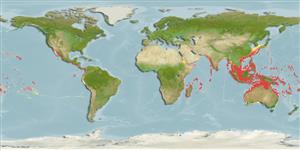Malacostraca |
Stomatopoda |
Lysiosquillidae
Environment: milieu / climate zone / depth range / distribution range
Ecology
Reef-associated; depth range 6 - 145 m (Ref. 96667). Tropical
Indo-Pacific.
Length at first maturity / Size / Weight / Age
Maturity: Lm ? range ? - ? cm Max length : 38.5 cm TL male/unsexed; (Ref. 3145)
Raptorial claw, 4 cm long. Banded with alternate light and dark bands.
Collected with spears, snares and bait, or at night with light nets (Ref. 92). Burrows in level bottoms near shore (Refs. 92, 80410); and swims at night (Ref. 80410). Intertidal to subtidal (Ref. 106854).
Life cycle and mating behavior
Maturity | Reproduction | Spawning | Eggs | Fecundity | Larvae
Some members of the order Stomatopoda pair for life and some come together only to mate. Males produce sperm ducts rather than spermatophores; females can brood a maximum of 50,000 eggs. Life cycle: Eggs hatch to a planktonic zoea which lasts for 3 months.
Manning, R.B. 1998 Stromatopods. p. 827-849. In Carpenter, K.E. and V.H. Niem (eds.) FAO Species Identifidication Guide for Fishery Purposes. The Living Marine Resources of the Western Central Pacific. Vol. 2. Cephalopods, crustaceans, holothurians and sharks. FAO Rome. (Ref. 92)
IUCN Red List Status
(Ref. 130435: Version 2025-1)
CITES status (Ref. 108899)
Not Evaluated
Not Evaluated
Threat to humans
Harmless
Human uses
| FishSource |
Tools
More information
Trophic EcologyFood items (preys)
Diet composition
Food consumption
Predators
Population dynamicsGrowth
Max. ages / sizes
Length-weight rel.
Length-length rel.
Length-frequencies
Mass conversion
Abundance
Life cycleReproductionMaturityFecunditySpawningEggsEgg developmentLarvae PhysiologyOxygen consumption
Human RelatedStamps, coins, misc.
Internet sources
Estimates based on models
Preferred temperature
(Ref.
115969): 22.6 - 29, mean 27.9 (based on 2362 cells).
Fishing Vulnerability
Low to moderate vulnerability (29 of 100).
Price category
Unknown.
